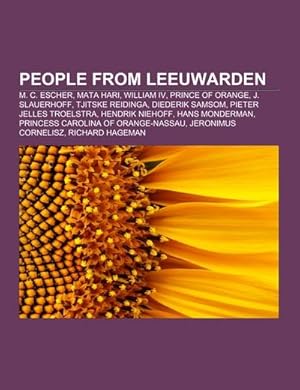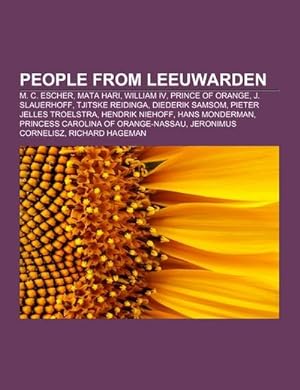9781155953045 (2 results)
Product Type
- All Product Types
- Books (2)
- Magazines & Periodicals
- Comics
- Sheet Music
- Art, Prints & Posters
- Photographs
- Maps
-
Manuscripts &
Paper Collectibles
Condition
- All Conditions
- New
- Used
Binding
- All Bindings
- Hardcover
- Softcover
Collectible Attributes
- First Edition
- Signed
- Dust Jacket
- Seller-Supplied Images
- Not Printed On Demand
Seller Location
Seller Rating
-
People from Leeuwarden
Published by Reference Series Books LLC Jul 2011, 2011
ISBN 10: 1155953045ISBN 13: 9781155953045
Seller: BuchWeltWeit Ludwig Meier e.K., Bergisch Gladbach, Germany
Book Print on Demand
Taschenbuch. Condition: Neu. This item is printed on demand - it takes 3-4 days longer - Neuware -Source: Wikipedia. Pages: 42. Chapters: M. C. Escher, Mata Hari, William IV, Prince of Orange, J. Slauerhoff, Tjitske Reidinga, Diederik Samsom, Pieter Jelles Troelstra, Hendrik Niehoff, Hans Monderman, Princess Carolina of Orange-Nassau, Jeronimus Cornelisz, Richard Hageman, Menno van Coehoorn, Dirk van Erp, Theo de Jong, Foeke Booy, Saskia van Uylenburgh, Max Blokzijl, Bert Sas, Joachim van Plettenberg, George Arnold Escher, Femme Gaastra, Douwe Sirtema van Grovestins, Haije Kramer, Princess Amalia of Nassau-Dietz, Abraham Lambertsz van den Tempel, Hans Vredeman de Vries, Obbe Philips, Querelle Jansen, Piet Wildschut, Piet Paaltjens, Wilhelmus à Brakel, Rune Massing, Bert Bakker, Wybrand de Geest, Havank, Richard Schuil, Piter Wilkens, Dirk Philips, Harm Wiersma, Hendrik Wouda, Oeki Hoekema, Wim Cohen, L. Bouke van der Meer, Jacob Baart de la Faille, Theodoor Hendrik van de Velde, Koos Formsma, Cornelis Adriaan Lobry van Troostenburg de Bruyn, Pieter Oosterhoff, Max Dwinger, Titia Bergsma, Ate Faber, Rienk Jelgerhuis, Campeius Vitringa, Theodorus van Kooten, Wigerus Vitringa, Thomas Peters, Juriaen Jacobsze, Dominicus Arumaeus, Jonathan Joosten, Johannes Henricus Gerardus Jansen, Lodewijk Caspar Valckenaer, Bernard Accama, Sijtse Jansma, Gerhard Westermann, Matthijs Harings, Folkert Posthuma, Jaap Boersma, Cisca Dresselhuys, Tom Pitstra, Matthijs Accama, Willem van Haren, Siwart Haverkamp. Excerpt: Maurits Cornelis Escher (17 June 1898 27 March 1972), usually referred to as M.C. Escher (English pronunciation: , Dutch: ), was a Dutch graphic artist. He is known for his often mathematically inspired woodcuts, lithographs, and mezzotints. These feature impossible constructions, explorations of infinity, architecture, and tessellations. Maurits Cornelis, nicknamed 'Mauk', was born in Leeuwarden, The Netherlands, in a house that forms part of the Princessehof Ceramics Museum today. He was the youngest son of civil engineer George Arnold Escher and his second wife, Sara Gleichman. In 1903, the family moved to Arnhem where he attended primary school and secondary school until 1918. He was a sickly child, and was placed in a special school at the age of seven and failed the second grade. Though he excelled at drawing, his grades were generally poor. He also took carpentry and piano lessons until he was thirteen years old. In 1919, Escher attended the Haarlem School of Architecture and Decorative Arts. He briefly studied architecture, but he failed a number of subjects (partly due to a persistent skin infection) and switched to decorative arts. Here he studied under Samuel Jessurun de Mesquita, with whom he would remain friends for years. In 1922 Escher left the school, having gained experience in drawing and making woodcuts. In 1922, an important year of his life, Escher traveled through Italy (Florence, San Gimignano, Volterra, Siena, Ravello) and Spain (Madrid, Toledo, Granada). He was impressed by the Italian countryside and by the Alhambra, a fourteenth-century Moorish castle in Granada, Spain. He came back to Italy regularly in the following years. In Italy he met Jetta Umiker, whom he married in 1924. The young couple settled down in Rome and stayed there until 1935, when the political climate under Mussolini became unbearable. Their son, Giorgio Arnaldo Escher, named after his grandfather, was born in Rome. The family next moved to Château-d' x, Switzerland, 42 pp. Englisch.
-
People from Leeuwarden : M. C. Escher, Mata Hari, William IV, Prince of Orange, J. Slauerhoff, Tjitske Reidinga, Diederik Samsom, Pieter Jelles Troelstra, Hendrik Niehoff, Hans Monderman, Princess Carolina of Orange-Nassau, Jeronimus Cornelisz, Richard Hageman
Published by Books LLC, Reference Series
ISBN 10: 1155953045ISBN 13: 9781155953045
Seller: AHA-BUCH GmbH, Einbeck, Germany
Book Print on Demand
Taschenbuch. Condition: Neu. nach der Bestellung gedruckt Neuware - Printed after ordering - Source: Wikipedia. Pages: 42. Chapters: M. C. Escher, Mata Hari, William IV, Prince of Orange, J. Slauerhoff, Tjitske Reidinga, Diederik Samsom, Pieter Jelles Troelstra, Hendrik Niehoff, Hans Monderman, Princess Carolina of Orange-Nassau, Jeronimus Cornelisz, Richard Hageman, Menno van Coehoorn, Dirk van Erp, Theo de Jong, Foeke Booy, Saskia van Uylenburgh, Max Blokzijl, Bert Sas, Joachim van Plettenberg, George Arnold Escher, Femme Gaastra, Douwe Sirtema van Grovestins, Haije Kramer, Princess Amalia of Nassau-Dietz, Abraham Lambertsz van den Tempel, Hans Vredeman de Vries, Obbe Philips, Querelle Jansen, Piet Wildschut, Piet Paaltjens, Wilhelmus à Brakel, Rune Massing, Bert Bakker, Wybrand de Geest, Havank, Richard Schuil, Piter Wilkens, Dirk Philips, Harm Wiersma, Hendrik Wouda, Oeki Hoekema, Wim Cohen, L. Bouke van der Meer, Jacob Baart de la Faille, Theodoor Hendrik van de Velde, Koos Formsma, Cornelis Adriaan Lobry van Troostenburg de Bruyn, Pieter Oosterhoff, Max Dwinger, Titia Bergsma, Ate Faber, Rienk Jelgerhuis, Campeius Vitringa, Theodorus van Kooten, Wigerus Vitringa, Thomas Peters, Juriaen Jacobsze, Dominicus Arumaeus, Jonathan Joosten, Johannes Henricus Gerardus Jansen, Lodewijk Caspar Valckenaer, Bernard Accama, Sijtse Jansma, Gerhard Westermann, Matthijs Harings, Folkert Posthuma, Jaap Boersma, Cisca Dresselhuys, Tom Pitstra, Matthijs Accama, Willem van Haren, Siwart Haverkamp. Excerpt: Maurits Cornelis Escher (17 June 1898 27 March 1972), usually referred to as M.C. Escher (English pronunciation: , Dutch: ), was a Dutch graphic artist. He is known for his often mathematically inspired woodcuts, lithographs, and mezzotints. These feature impossible constructions, explorations of infinity, architecture, and tessellations. Maurits Cornelis, nicknamed 'Mauk', was born in Leeuwarden, The Netherlands, in a house that forms part of the Princessehof Ceramics Museum today. He was the youngest son of civil engineer George Arnold Escher and his second wife, Sara Gleichman. In 1903, the family moved to Arnhem where he attended primary school and secondary school until 1918. He was a sickly child, and was placed in a special school at the age of seven and failed the second grade. Though he excelled at drawing, his grades were generally poor. He also took carpentry and piano lessons until he was thirteen years old. In 1919, Escher attended the Haarlem School of Architecture and Decorative Arts. He briefly studied architecture, but he failed a number of subjects (partly due to a persistent skin infection) and switched to decorative arts. Here he studied under Samuel Jessurun de Mesquita, with whom he would remain friends for years. In 1922 Escher left the school, having gained experience in drawing and making woodcuts. In 1922, an important year of his life, Escher traveled through Italy (Florence, San Gimignano, Volterra, Siena, Ravello) and Spain (Madrid, Toledo, Granada). He was impressed by the Italian countryside and by the Alhambra, a fourteenth-century Moorish castle in Granada, Spain. He came back to Italy regularly in the following years. In Italy he met Jetta Umiker, whom he married in 1924. The young couple settled down in Rome and stayed there until 1935, when the political climate under Mussolini became unbearable. Their son, Giorgio Arnaldo Escher, named after his grandfather, was born in Rome. The family next moved to Château-d' x, Switzerland,



